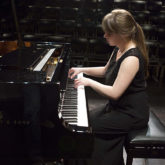
Budapest
Bizet, Saint-Saens, Berlioz
Kobayashi Season Pass 4.
BIZET: L’Arlésienne – excerpts from Suites 1 and 2
As director of the Vaudevile Theatre in Paris, Léon Carvalho attempted to revive the genre of French melodrama. He asked Georges Bizet to compose music to accompany Alphonse Daudet’s play, The Girl From Arles (L’Arlésienne). Following a disappointing premier, Bizet arranged an orchestral suite from fragments of the accompanying music, which we know today as Suite No. 1 of L’Arlésienne. Suite No. 2 was arranged by Bizet’s friend, Ernest Giraud, after the composer’s death. Each suite contains four movements, which are often heard in orchestral concerts.
SAINT-SAЁNS: Piano Concerto No. 5 in F major, „The Egyptian” op. 103
I. Allegro animato II. Andante III. Molto allegro
An outstanding pianist and organist, Saint-Saëns (1835–1921) travelled widely and was particularly fond of North Africa. His fifth piano concerto is often referred to as “The Egyptian”, largely because of the eastern melodies found in its second movement. The first movement, sonata-like and embellished with unique French colour, recalls the influence of Beethoven and other early romantic masters. A challenge to the soloist’s technical skill, the finale invokes airy dancing music which, according to a contemporary observer, seems to evoke “a happy return to the boulevards of Paris” following a trip to Egypt.
BERLIOZ: Symphonie Fantastique, op. 14
I. Reveries and Passions – Largo-Allegro II. The Ball – Valse. Allegro non troppo III. Scene from the Meadows – Adagio IV. March to the Scaffold – Allegretto non troppo V. Dream of the Witches’ Sabbath – Larghetto-Allegro
Berlioz gave no less than 14 different descriptions of the poetic programme behind his Symphonie Fantastique. There are no profound variations among the different versions: in each „The Artist” as the principal player of the work, is tortured by a single obsession: love. In the first movement, after a lengthy introduction, we hear the „idée fixe”, commencing with a break down of a C major chord. This is the melody of the obsession. In the second movement, our hero appears at an imaginary ball: here he sees the ideal of his dreams (and we also hear a Waltz that has been described as the finest that Tchaikovsky did not write!). The Scene from the Meadows then offers us some breathing space. The artist seems to seek oblivion in nature. We hear the sounds of shepherd’s flutes and the approaching storm. But there is no escaping the obsession. The unhappy Artist elects to commit suicide by ingesting opium, but he takes too little and experiences two narcotic induced nightmares. In the first (the Fourth movement) he thinks he has murdered his love and is marched to the scaffold to be executed. In the fifth, he sees a Witches Sabbath, and his former ideal, the woman at the centre of his heart, is here espied among the hags – her melody now bizarrely distorted. And we also hear the music of the final judgement, the Dies irae melody (beloved by many composers such as Liszt and Rachmaninov) attributed to Thomas of Celano.
The Symphony was premiered in Paris on December 5th 1830. Berlioz’s inspiration for composing this remarkable work was his own romantic obsession for the Irish actress Harriet Smithson, who initially rejected his advances. Several years later, however, after Berlioz had used this symphony to exorcise her ghost, so to speak, they met again and eventually did marry in 1834.




